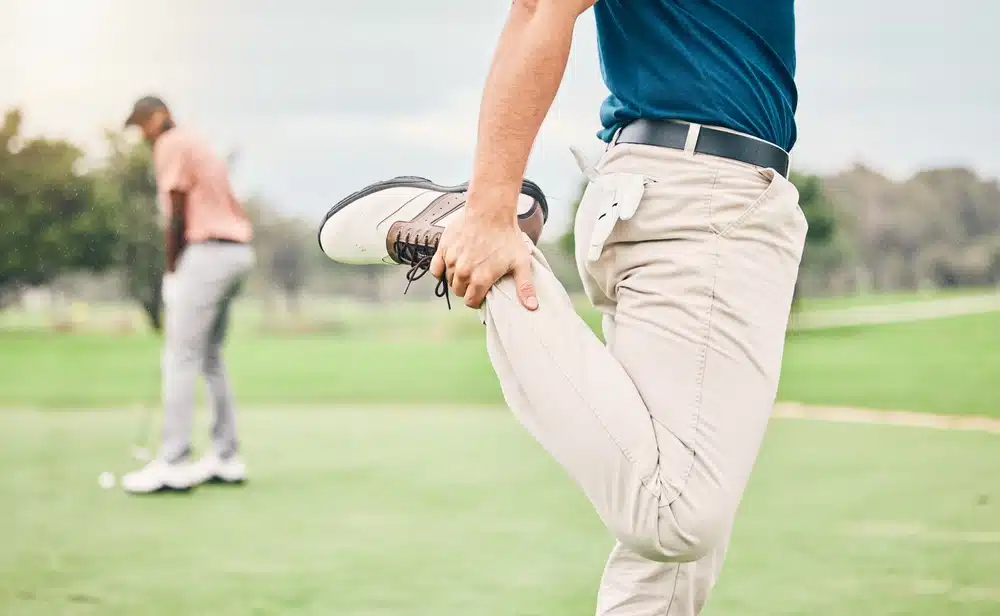Hit the links without hurting this year—what are the best exercises to support golfer’s backs?
In a recent blog post, we went over the most frequent injuries golfer’s experience, and what commonly causes them. In today’s article, we’d like to discuss the best exercises, tips, and equipment to prevent or recover from those issues.
Best exercises to combat back pain
A combination of strengthening and stretching your muscles is key to preventing and/or reducing back pain. Here are the most recommended options for each!
Side Planks
Your core muscles help your pelvis, hips, lower back, and abdomen—all the major body parts involved in a golf swing—work together cohesively. To strengthen your core, incorporate side planks into your workouts.
Start on one side with your feet stacked and elbow directly below your shoulder. To lift into plank, contract your core and raise your hips until you form a straight line with your body. For a more advanced stretch, raise your top hand toward the ceiling. Hold for 15 seconds, release, and switch sides. Repeat the exercise three times.
Openers
The name says it all—openers expand space in your lower back, promoting flexibility and increasing range of motion. They provide major pain relief as well as improve your backswing.
Begin the stretch by laying on your side. Rather than extending your legs and stacking your feet, as you did with side planks, bend your knees at approximately 90 degrees. Extend both arms. Now, raise and rotate the top arm until it rests on the other side of your body, keeping your lower shoulder on the floor. Hold for 20 to 30 seconds. Then, roll over and repeat on the opposite side.
Quadruped Rocking
Quadruped rocking targets the hips and full length of the spine. Like openers and side planks, it fosters stability and proper posture. We’re including it here because it also prepares your body for the bending and squatting that often accompanies golf.
Begin this exercise on all fours with your hands under your shoulders and knees below your hips. Draw your stomach upward while still maintaining the natural curve of your lumbar region. Drop backward into your hips. You should feel a slight stretch in your lower back and hips. Repeat 10 to 15 times.
Equipment built for the way you play
Ergonomic equipment can also have a major impact on the level of pain in your golf game. From clubs designed to fit your body to bags that disperse pressure evenly, there are new innovations that can dramatically reduce the stress of the game on your back.
Custom-fitted clubs
Custom clubs take into account almost every aspect of your swing. Your height, arm length, hand size, swing speed, and trajectory of swing all are assessed and considered by a professional, who will then recommend the appropriate club length, grip size, head design, and shaft flex.
Perfectly proportioned bags
If you opt to walk the course rather than use a cart, your golf bag is of utmost importance to your back health. Choose a lightweight option (some weigh as little as 2.5 lbs), and consider the setup of the shoulder straps, handles, and load distribution. When the bag is fully loaded, the straps should sit comfortably between your chest and the edge of your shoulders, not slipping off the sides of your shoulders. The load should be spread evenly along the length of your back, not pulling your shoulders back or digging into your lower back. Handles should be padded and adjustable.
Additional tips and tricks
Just like with any sport, you can easily injure yourself in golf if you don’t take proper steps to train and prepare. Here are some tips from the experts at iSpine to ensure a safe and healthy round.
Warm up
Waking up for an early tee time, heading straight to the course and immediately loading a big swing is a surefire way to cause a back injury. Studies show that a quick warmup or stretch can reduce risk of injuries by up to 60%. Here are three commonly recommended warm up exercises:
- Jumping jacks to increase blood flow
- Stretches targeting the shoulders, torso, hips, and hamstrings
- Gentle practice swings
Focus on your swing technique
As we discussed in our last blog, improper swing form is a recipe for spinal disaster. Here are some areas in your form to focus on:
- Keep the spine upright—standing close to the ball helps
- Bend forward at the hips. Begin your swing by hinging at the hips first, rather than rounding the back.
- Bend slightly at the knees. About 25 degrees is optimal for a straight spine.
- Keep the feet shoulder-width apart and rotated outwards. This can help your hips rotate more powerfully, giving you the swing you want without compromising your spine.
Experiencing low back pain during your game?
The specialists at iSpine Clinics often see a correlation between the Shopping Cart disease and golfers. For those that use a cart to get around the course, we often see firsthand golfers take a shot and go back to the cart and find themselves leaning over the steering wheel to relieve low back pain. This can be an indication and something you should share with your doctor or during a consultation with iSpine Clinics.
Cool down
Just like you shouldn’t start cold, it’s not great for your body to suddenly quit without bringing the heart rate and blood pressure back to their resting state. Some recommended activities are a brisk walk, some easy yoga poses, or even a light massage—some clubhouses offer the service in-house.
Keep active and healthy this spring and summer
When the weather is agreeable, golf remains a favorite pastime in Minnesota. Even though it may seem less risky than our famous winter sports, there is still the chance for injury if you’re not careful. By following the advice of the iSpine back health experts, you can ensure a safe and enjoyable season. For even more tips, set up a Pain Care Consultation or a Rehabilitation and Physical Therapy Consultation, where our team of experts will learn more about your lifestyle, health history, and any major medical moments that might cause issues down the line and recommend a plan of action.


